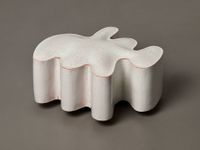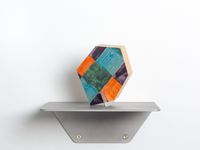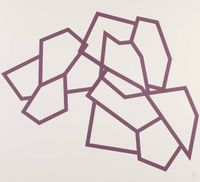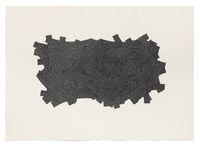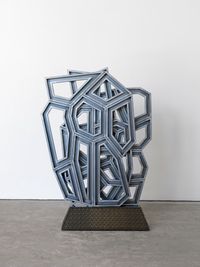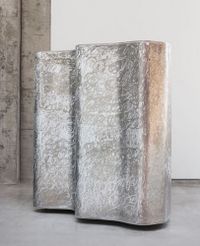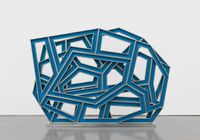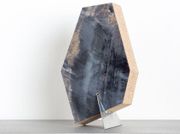Sinuous, angular, interlocking, or compact, Richard Deacon's abstract sculptures and installations are constructed from various materials encompassing laminated wood, steel, marble, clay, foam, and leather, among others. A leading figure of British sculpture since the 1980s, Deacon was the winner of the prestigious Turner Prize in 1987.
Read MoreDeacon holds a BA from Saint Martin's School of Art (1972) and an MA from Royal College of Art (1977), London.
Deacon often describes himself as a 'fabricator' rather than a sculptor, using the term 'fabrication' to denote both the act of building structures and storytelling, as he said in a 2019 interview with the San Francisco Museum of Modern Art.
The transformation of materials is central to Deacon's practice, in which they adopt impressive shapes as results of the artist's rigorous experimentation with different techniques. The resulting artworks, however, are far from seamless structures but expose the methods of their construction. In the floor sculpture This, That And The Other (1985), for example, the artist used a liberal amount of glue to hold strips of laminated wood together in a looping structure of curves, while screws and rivets are visible along the pieces of steel that form a second part of the work.
'Art For Other People', begun in 1982, also reflects Deacon's concern with diverse materials and the idea of enclosing invisible space. The bronze sculpture Art For Other People #6 (1983) resembles a ring, with a suede adornment where a jewel would normally sit, while curving bands of brass and foam create a cage-like form in Art for Other People #14 (1984).
In the mid-1980s, Deacon began an ongoing dialogue with his collaborators, including steel fabricator Gary Chapman, artist Matthew Perry, as well as ceramic sculptor Anna Zimmerman. The exchange of ideas and methods has led to the dynamic forms of Deacon's sculptures, such as the twisted flows of wood in Slippery When Wet (2004), made in collaboration with Perry.
Deacon's sculptural works have appeared in public spaces around the world in the past decades. In 1993, Antwerp's Middelheim Museum purchased Never Mind, a balloon-like structure made from birchwood that was installed in the museum's sculpture park. Once exposed to the elements, however, the work deteriorated and was removed, until the artist recreated it in stainless steel in 2017. The newly inaugurated Never Mind coincided with Some Time, Deacon's major solo exhibition at the museum.
The long-term project From There to Here (2006—2019) saw Deacon work with artist Mrdjan Bajic, resulting in a tall columnar sculpture on the Kalemegdan bridge in Belgrade, Serbia. In 2013, Deacon devised 39 ceramic tiles—each adorned with bold colours and patterns—that were installed on the facade of Piccadilly's One Eagle Place in collaboration with Eric Barry Architects.
Richard Deacon's solo exhibitions include Fourfold Way, Galerie Thomas Schulte, Berlin (2021); Deep State, Lisson Gallery, London (2019); House and Garden, Marian Goodman Gallery, New York (2019); Richard Deacon: New Sculpture, Beijing Commune (2018); On The Other Side, Kunstmuseum Winterthur, Switzerland (2015); Richard Deacon, Tate Britain, London (2014); Beware of the Dog, Singapore Tyler Print Institute (STPI), Singapore (2012); and The Missing Part, Musée d'art Moderne et Contemporain, Strasbourg, France (2010).
Selected group exhibitions include Sculpture Projects Pingyao, Shanxi, China (2019); The Matter in Harmony, Galerie Thomas Schulte, Berlin (2018); Collaborations, STPI, Singapore (2015); Here We Go: A Changing Group Show, Karsten Schubert, London (2013); Encounter: The Royal Academy in Asia, Institute of Contemporary Arts, Singapore (2012); Calder to Warhol: Introducing the Fisher Collection, San Francisco Museum of Modern Art (2010); British Council Collection: The Third Dimension, Whitechapel Gallery, London (2009); and History in the Making, Mori Art Museum, Tokyo (2008).
Deacon has also curated exhibitions, including Abstract Drawing, The Drawing Room, London (2014) and Summer Exhibition 2020, Royal Academy of Arts, London (2020). The artist was elected a Royal Academician in 1998 and made a Commander of the Order of the British Empire (CBE) in the following year.
Richard Deacon's website can be found here.
Sherry Paik | Ocula | 2021
